The Use of Bolted Side Plates for Shear Strengthening of RC Beams: A Review
Abstract
:1. Introduction
2. Experimental Section
3. FEM Modelling
3.1. Numerical Modelling
3.2. Comparison Between Experimental and Numerical Results
3.3. Parametric Study
- (1)
- The influence of different plate depth on the shear strengthening effect of BSP beams is shown in Figure 8. It is evident that the shear capacity, stiffness, ultimate deflection, and energy absorption increased with the plate depth. In addition, a greater plate depth caused larger transverse slip, which is because a deeper plate requires more anchor bolts to offer the same connection effect between the bolted steel plates and RC beams.
- (2)
- Thicker steel plate led to larger shear capacity, stiffness, and energy absorption as well as transverse slip.
- (3)
- When the yield strength of steel plate was larger than 300 MPa, the shear capacity, deformability, and the magnitude of transverse slip increased with the enlargement of yield strength, while that of stiffness was almost unchanged.
- (4)
- Although larger bolt diameter can raise the shear capacity, stiffness, and ultimate deflection, the improvement was negligible when the diameter was greater than 16 mm. Besides, the transverse slip decreased with the increase of bolt diameter, due to the stronger composite action between the steel plates and RC beam.
- (5)
- It is shown from Figure 9 that reducing the bolt spacing significantly improved the shear strength, stiffness, and deformability. The transverse slip decreased with an increasing bolt spacing, which was mainly caused by the better composite action.
- (6)
- The strengthening effect had little relation with the number of bolt rows (n). When n was greater than 3, the enhancement of shear performance had no evident variation. Therefore, n = 2 was a recommend number of bolt rows. The transverse slips decreased with the increasing of bolt rows.
- (7)
- Smaller shear span ratio generated larger shear bearing capacity, stiffness, and relative slips of BSP beams, while the ultimate deflection increased with the shear span ratio.
- (8)
- The increase in concrete strength resulted in greater shear bearing capacity, stiffness, deformability, and transverse slips.
- (9)
- Finally, it can be summarized that the cross-section of steel plate, bolt arrangement, shear span ratio and concrete strength affected the shear performance of BSP beams significantly. In addition, stronger bolt connection provided a reliable composite action in the steel plates and RC beam.
4. Theoretical Analysis
4.1. Shear Capacity Model Based on Deformation Compatibility
4.2. Shear Capacity Model Based on Simplified Transverse Slip
4.3. Validation of the Proposed Theoretical Models
5. Conclusions
Author Contributions
Funding
Conflicts of Interest
References
- Triantafillou, T.C. Shear stregthening of reinforced concrete beams using epoxy-bonded FRP composites. Struct. J. 1998, 95, 107–115. [Google Scholar]
- Deniaud, C.; Cheng, J.J.R. Shear behavior of reinforced concrete T-beams with externally bonded fiber-reinforced polymer sheets. Struct. J. 2001, 98, 386–394. [Google Scholar]
- Park, D.G.; Cho, J.Y.; Oh, B.H. Failure behavior and separation criterion for strengthened concrete members with steel plates. J. Struct. Eng. 2003, 129, 1191–1198. [Google Scholar]
- Li, L.Z.; Lo, S.H.; Su, R.K.L. Experimental study of moderately reinforced concrete beams strengthened with bolted-side steel plates. Adv. Struct. Eng. 2013, 16, 499–516. [Google Scholar] [CrossRef] [Green Version]
- Barnes, R.A.; Baglin, P.S.; Mays, G.C.; Subedi, N.K. External steel plate systems for the shear strengthening of reinforced concrete beams. Eng. Struct. 2001, 23, 1162–1176. [Google Scholar] [CrossRef]
- Adhikary, B.B.; Mutsuyoshi, H.; Sano, M. Shear strengthening of reinforced concrete beams using steel plates bonded on beam web: Experiments and analysis. Constr. Build. Mater. 2000, 14, 237–244. [Google Scholar] [CrossRef]
- Roberts, T.M.; Haji-Kazemi, H. Strengthening of under-reinforced concrete beams with mechanically attached steel plates. Int. J. Cement Compos. Lightweight Concr. 1989, 11, 21–27. [Google Scholar] [CrossRef]
- Altun, F. An experimental study of the jacketed reinforced-concrete beams under bending. Constr. Build. Mater. 2004, 18, 611–618. [Google Scholar] [CrossRef]
- Chalioris, C.E.; Thermou, G.E.; Pantazopoulou, S.J. Behaviour of rehabilitated RC beams with self-compacting concrete jacketing—Analytical model and test results. Constr. Build. Mater. 2014, 55, 257–273. [Google Scholar] [CrossRef]
- Yu, K.Q.; Li, L.Z.; Yu, J.T.; Xiao, J.Z.; Ye, J.H.; Wang, Y.C. Feasibility of using ultra-high ductility cementitious composites for concrete structures without steel rebar. Eng. Struct. 2018, 170, 11–20. [Google Scholar] [CrossRef]
- Ombres, L.; Verre, S. Shear Performance of FRCM Strengthened RC Beams. Spec. Publ. 2018, 324, 7.1–7.22. [Google Scholar]
- Gao, W.Y.; Dai, J.G.; Teng, J.G. Fire resistance design of un-protected FRP-strengthened RC beams. Mater. Struct. 2016, 49, 5357–5371. [Google Scholar] [CrossRef]
- Aram, M.R.; Czaderski, C.; Motavalli, M. Debonding failure modes of flexural FRP-strengthened RC beams. Compos. Part B 2008, 39, 826–841. [Google Scholar] [CrossRef]
- Sas, G.; Carolin, A.; Täljsten, B. A model for predicting the shear bearing capacity of FRP-strengthened beams. Mech. Compos. Mater. 2008, 44, 245–256. [Google Scholar] [CrossRef]
- Yu, J.T.; Liu, K.K.; Li, L.Z.; Wang, Y.C.; Yu, K.Q.; Xu, Q.F. A simplified method to predict the fire resistance of RC Beams strengthened with near-surface mounted CFRP. Compos. Struct. 2018, 193, 1–7. [Google Scholar] [CrossRef]
- Hawileh, R.; Rami, A.; Abdalla, J.A.; Tanarslan, M.; Naser, M.Z. Modeling of nonlinear cyclic response of shear-deficient RC T-beams strengthened with side bonded CFRP fabric strips. Comput. Concr. 2011, 8, 193–206. [Google Scholar] [CrossRef]
- Hassan, T.K.; Tarek Rizkalla, S.H. Flexural strengthening of prestressed bridge slabs with FRP systems. Pci J. 2002, 47, 76–93. [Google Scholar] [CrossRef]
- Yu, J.T.; Wang, Y.C.; Zhan, K.L.; Li, L.Z.; Yu, K.Q. Using XFEM to model the effect of different axial compression on the hysteretic behaviour of the flexure-dominant RC columns. Struct. Des. Tall Spec. 2018, e1465. [Google Scholar] [CrossRef]
- Hawileh, R.; Abdalla, J.A.; Naser, M.Z.; Tanarslan, M. Finite element modeling of shear deficient RC beams strengthened with NSM CFRP rods under cyclic loading. Spec. Publ. 2015, 301, 1–18. [Google Scholar]
- Rizkalla, S.H.; Hassan, T.K.; Lucier, G. FRP Shear Transfer Mechanism for Precast, Prestressed Concrete Sandwich Load-Bearing Panels. Spec. Publ. 2009, 265, 603–625. [Google Scholar]
- Su, R.K.L.; Zhu, Y. Experimental and numerical studies of external steel plate strengthened reinforced concrete coupling beams. Eng. Struct. 2005, 27, 1537–1550. [Google Scholar] [CrossRef] [Green Version]
- Alam, M.A.; Jumaat, M.Z. Eliminating premature end peeling of flexurally strengthened reinforced concrete beams. J. Appl. Sci. 2009, 9, 1106–1113. [Google Scholar] [CrossRef]
- Oehlers, D.J.; Ahmed, M.; Nguyen, N.T.; Bradford, M.A. Retrofitting reinforced concrete beams by bolting steel plates to their sides. Part 2: Transverse interaction and rigid plastic design. Struct. Eng. Mech. 2000, 10, 227–243. [Google Scholar] [CrossRef]
- Li, L.Z.; Cai, Z.W.; Lu, Z.D.; Zhang, X.L.; Wang, L. Shear performance of bolted side-plated reinforced concrete beams. Eng. Struct. 2017, 144, 73–87. [Google Scholar] [CrossRef]
- Su, R.K.L.; Li, L.Z.; Lo, S.H. Shear transfer in bolted side-plated reinforced concrete beams. Eng. Struct. 2013, 56, 1372–1383. [Google Scholar] [CrossRef] [Green Version]
- Jiang, C.J.; Lu, Z.D.; Li, L.Z. Shear performance of fire-damaged reinforced concrete beams repaired by a bolted side-plating technique. J. Struct. Eng. ASCE 2017, 143, 4017007. [Google Scholar] [CrossRef]
- Li, L.Z.; Jiang, C.J.; Liu, B.Z.; Lu, Z.D. Shear strengthening of fire-damaged reinforced concrete beams using bolted-side plating. Procedia Eng. 2017, 210, 186–195. [Google Scholar] [CrossRef]
- Li, L.Z.; Jiang, C.J.; Jia, L.J.; Lu, Z.D. Local buckling of bolted steel plates with different stiffener configuration. Eng. Struct. 2016, 119, 186–197. [Google Scholar] [CrossRef]
- Su, R.K.L.; Li, L.Z.; Lo, S.H. Longitudinal partial interaction in bolted side-plated reinforced concrete beams. Adv. Struct. Eng. 2014, 17, 921–936. [Google Scholar] [CrossRef]
- Lo, S.H.; Li, L.Z.; Su, R.K.L. Optimization of partial interaction in bolted side-plated reinforced concrete beams. Comput. Struct. 2014, 131, 70–80. [Google Scholar] [CrossRef]
- Xu, X.L.; Lu, Z.D.; Li, L.Z.; Jiang, C.J. Numerical study on the local buckling behaviour of bolted steel plates in steel jacketing. Adv. Mater. Sci. Eng. 2017, 2017, 1352084. [Google Scholar] [CrossRef]
- Li, L.Z.; Wu, Z.L.; Yu, J.T.; Wang, X.; Zhang, J.X.; Lu, Z.D. Numerical simulation of the shear capacity of bolted side-plated RC beams. Eng. Struct. 2018, 171, 373–384. [Google Scholar] [CrossRef]
- Xie, L.; Lu, X.; Lu, X.; Huang, Y.; Ye, L. Multi-layer shell element for shear walls in OpenSees. In Proceedings of the International Conference on Computing in Civil and Building Engineering, Orlando, FL, USA, 23–25 June 2014; pp. 1190–1197. [Google Scholar]
- Faria, R.; Pouca, N.S.V.; Delgado, R. Simulation of the cyclic behaviour of R/C rectangular hollow section bridge piers via a detailed numerical model. J. Earthq. Eng. 2004, 8, 725–748. [Google Scholar] [CrossRef]
- Wang, L.; Liu, Z.; Zhang, X. Global Dynamics of an Sveir Epidemic Model With Distributed Delay and Nonlinear Incidence; Elsevier Science Inc.: Amsterdam, The Netherlands, 2016. [Google Scholar]
- Tsuboi, Y.; Tanaka, H.; Suenaga, Y. A study on failure of reinforced concrete members under combined stresses (part 4): Especially on beam under bending moment and shearing force. Trans. Archit. Inst. Jpn. 1961, 67, 1–9. [Google Scholar] [CrossRef]
- Li, L.Z.; Jiang, C.J.; Su, R.K.L.; Lo, S.H. Design of bolted side-plated reinforced-concrete beams with partial interaction. Struct. Build. 2016, 169, 81–95. [Google Scholar] [CrossRef]
- Li, L.Z.; Jiang, C.J.; Su, R.K.L.; Lo, S.H. A piecewise linear transverse shear transfer model for bolted side-plated beams. Struct. Eng. Mech. 2017, 62, 443–453. [Google Scholar] [CrossRef]
- Smith, S.T.; Bradford, M.A.; Oehlers, D.J. Buckling tests on steel plates restrained at discrete points in the retrofit of reinforced concrete beams. Proc. ICE-Struct. Build. 2001, 146, 115–127. [Google Scholar] [CrossRef]
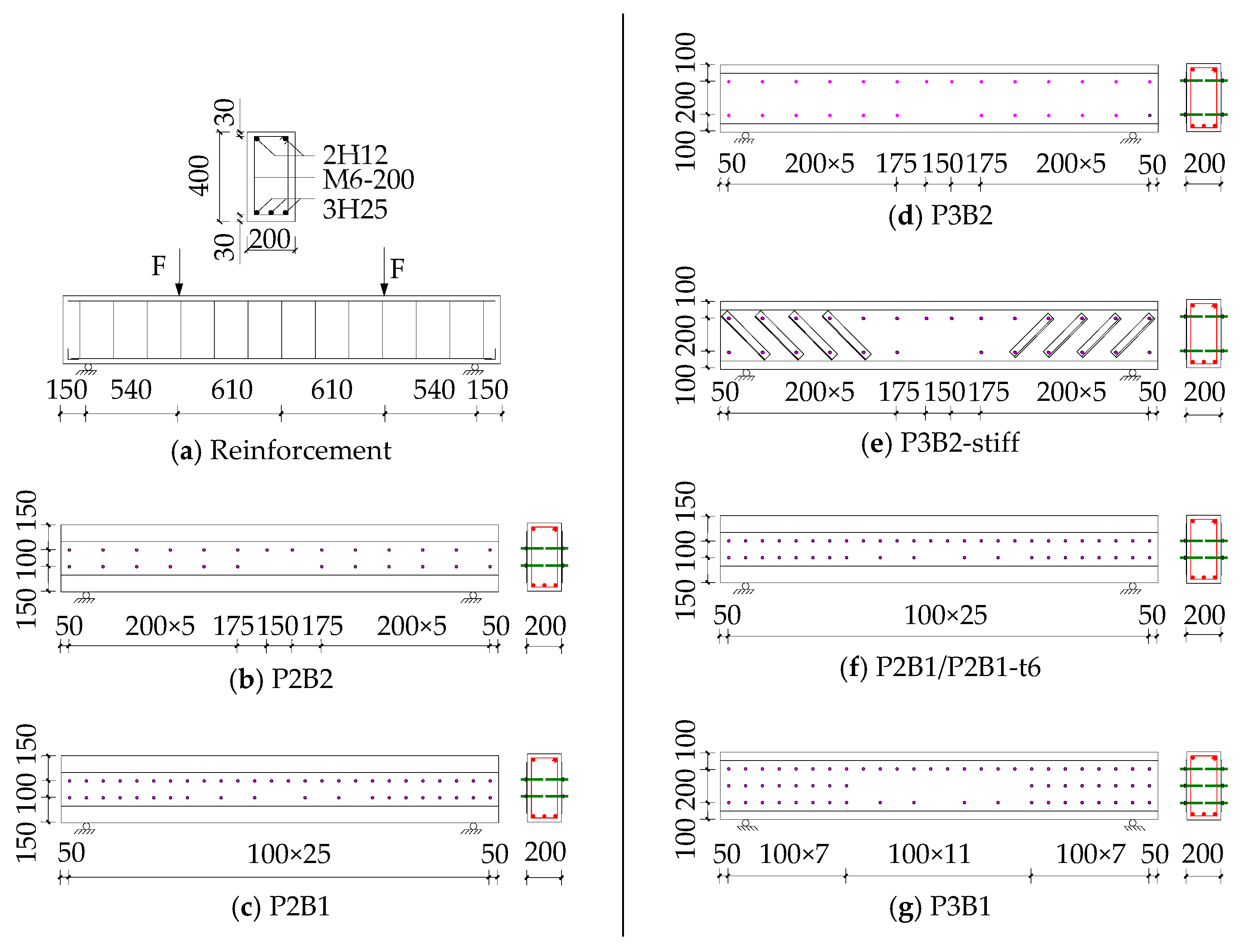
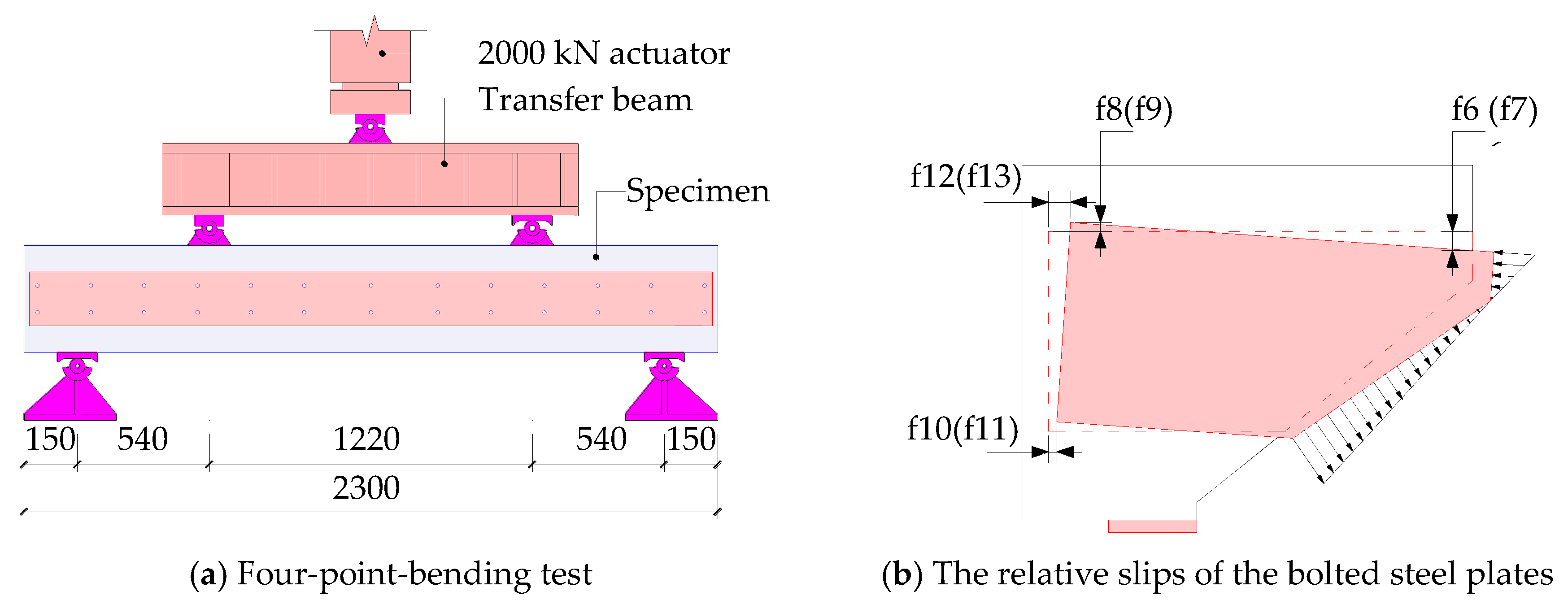


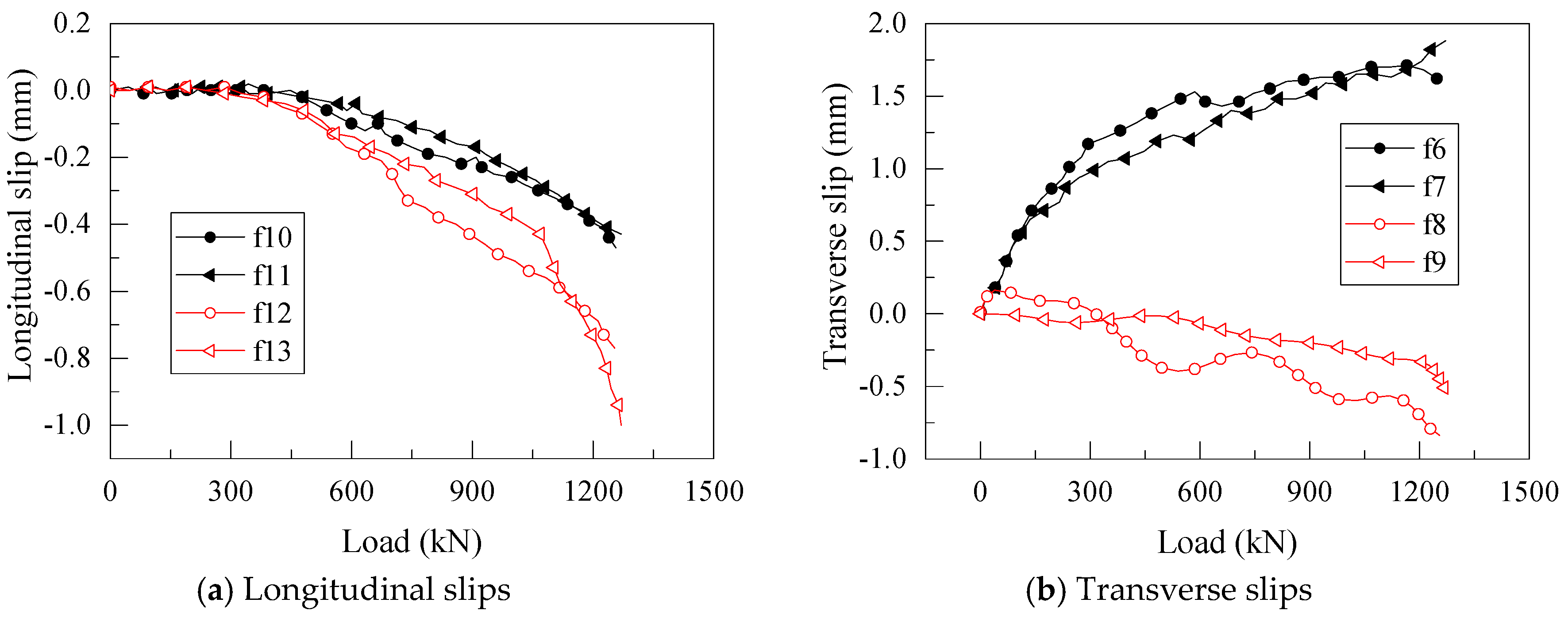
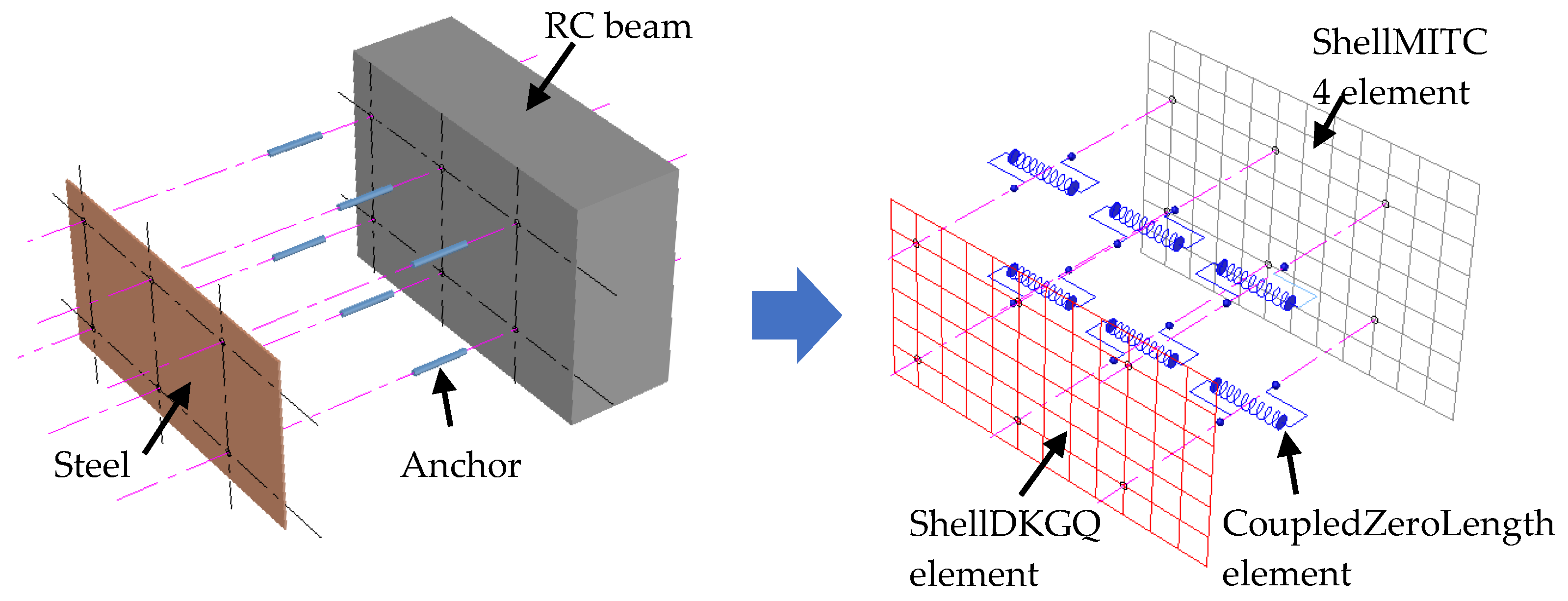
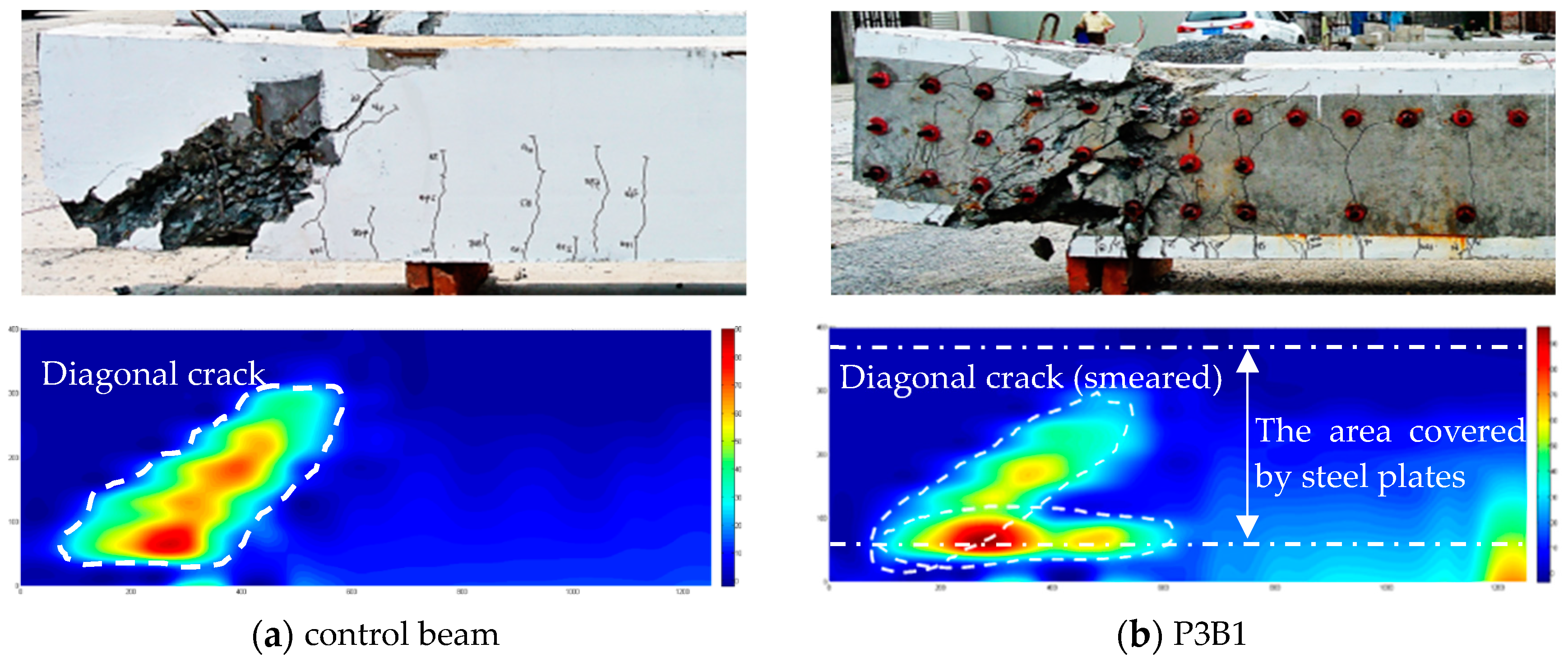
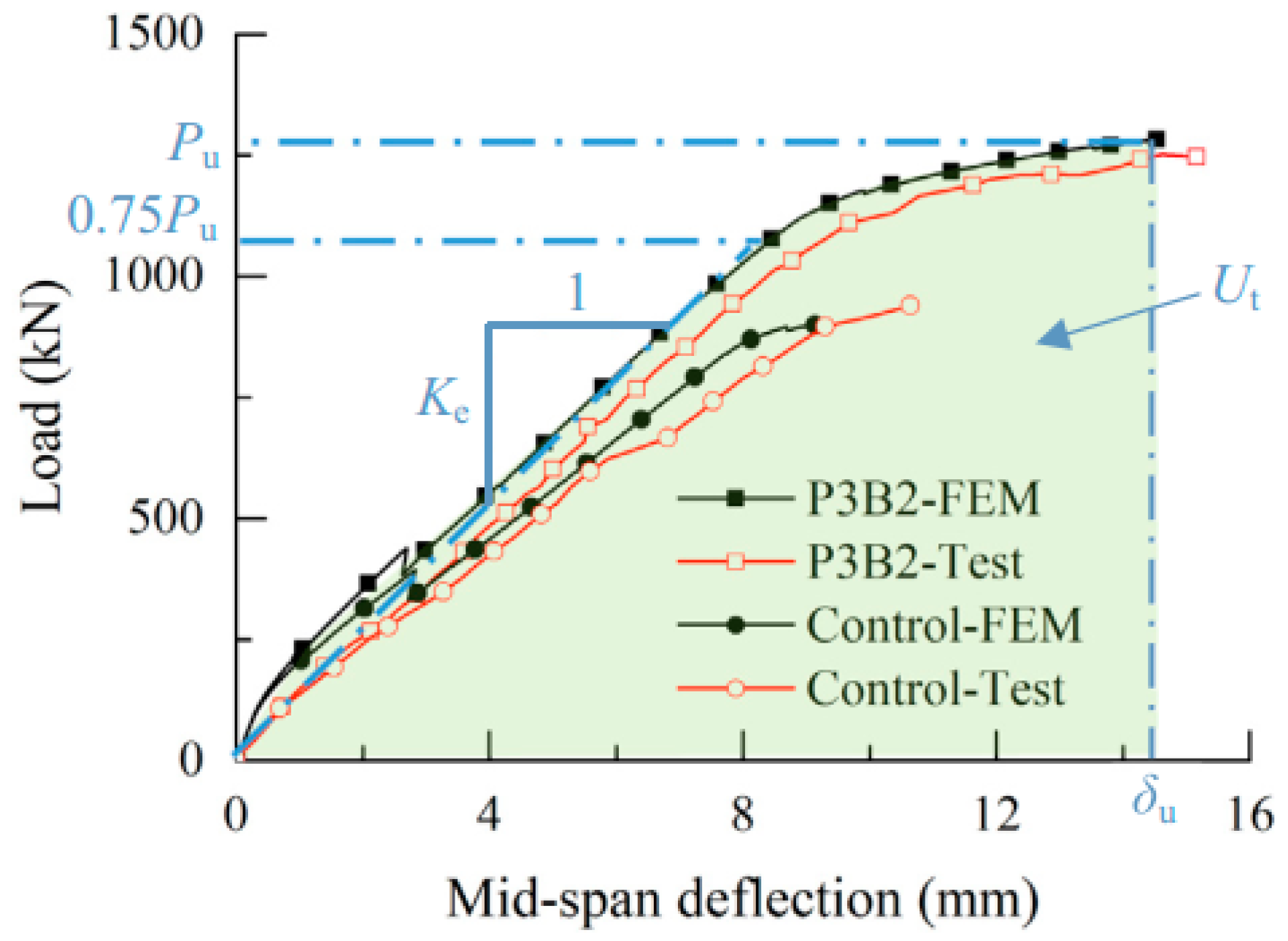

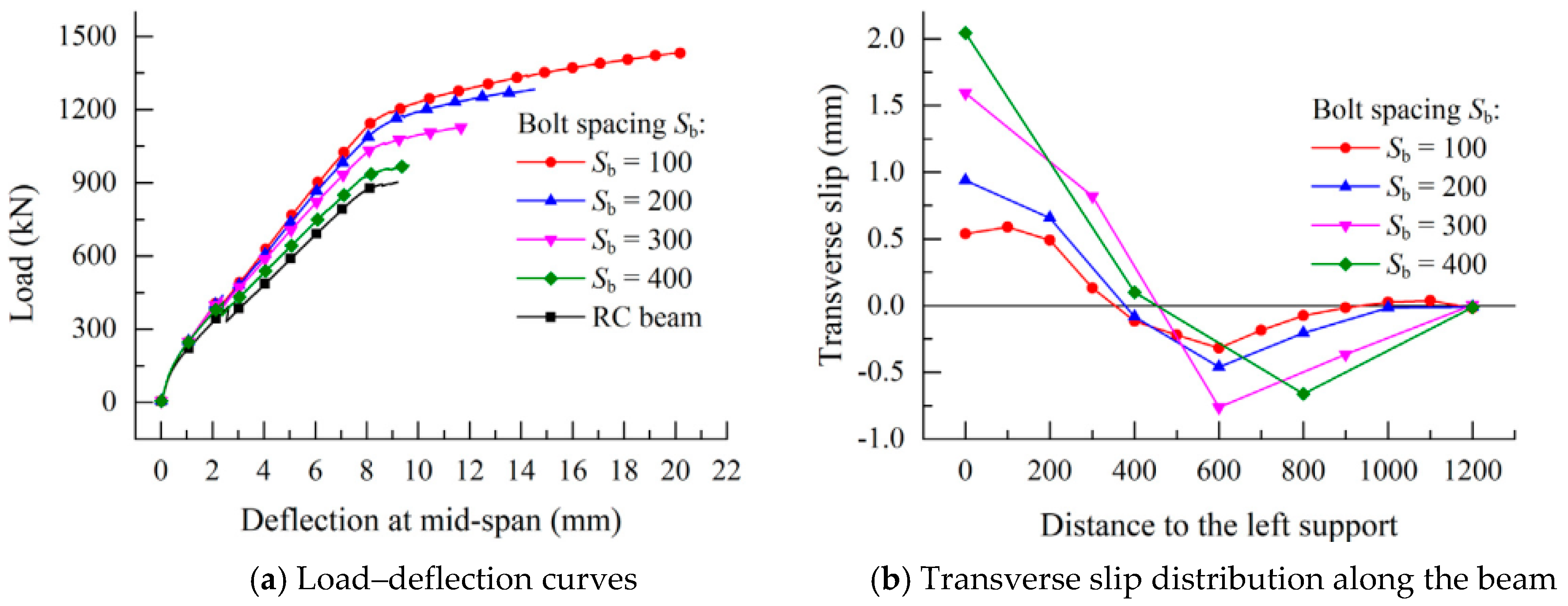
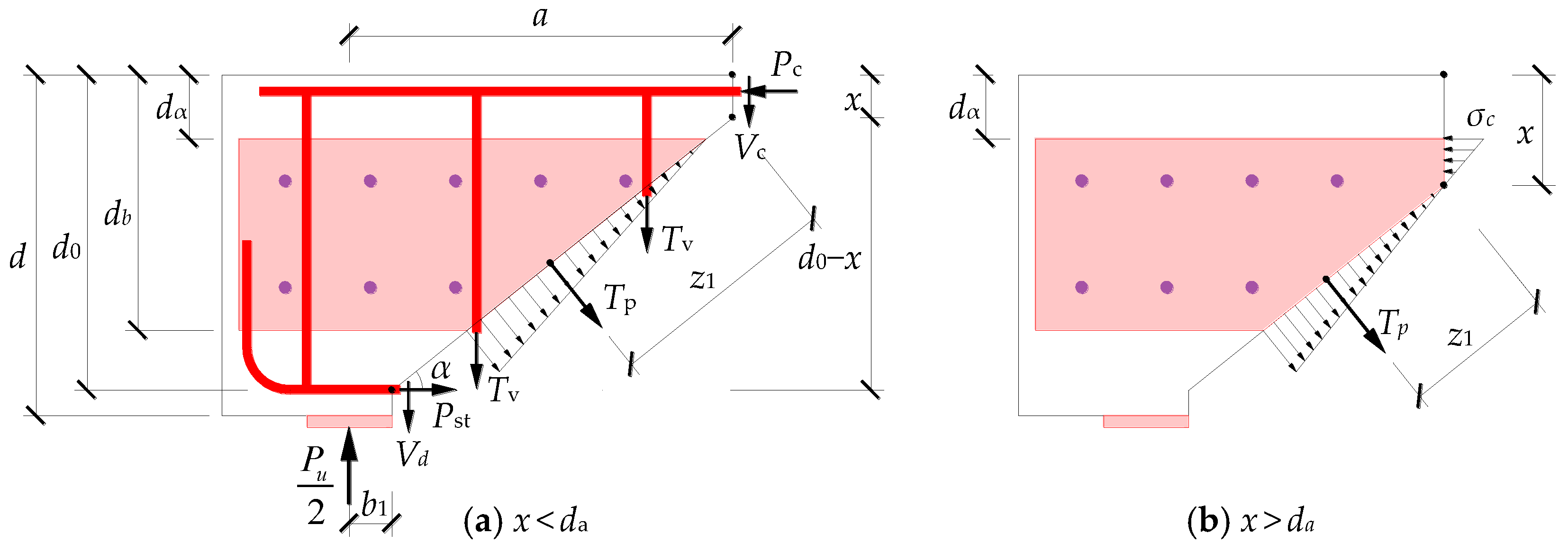
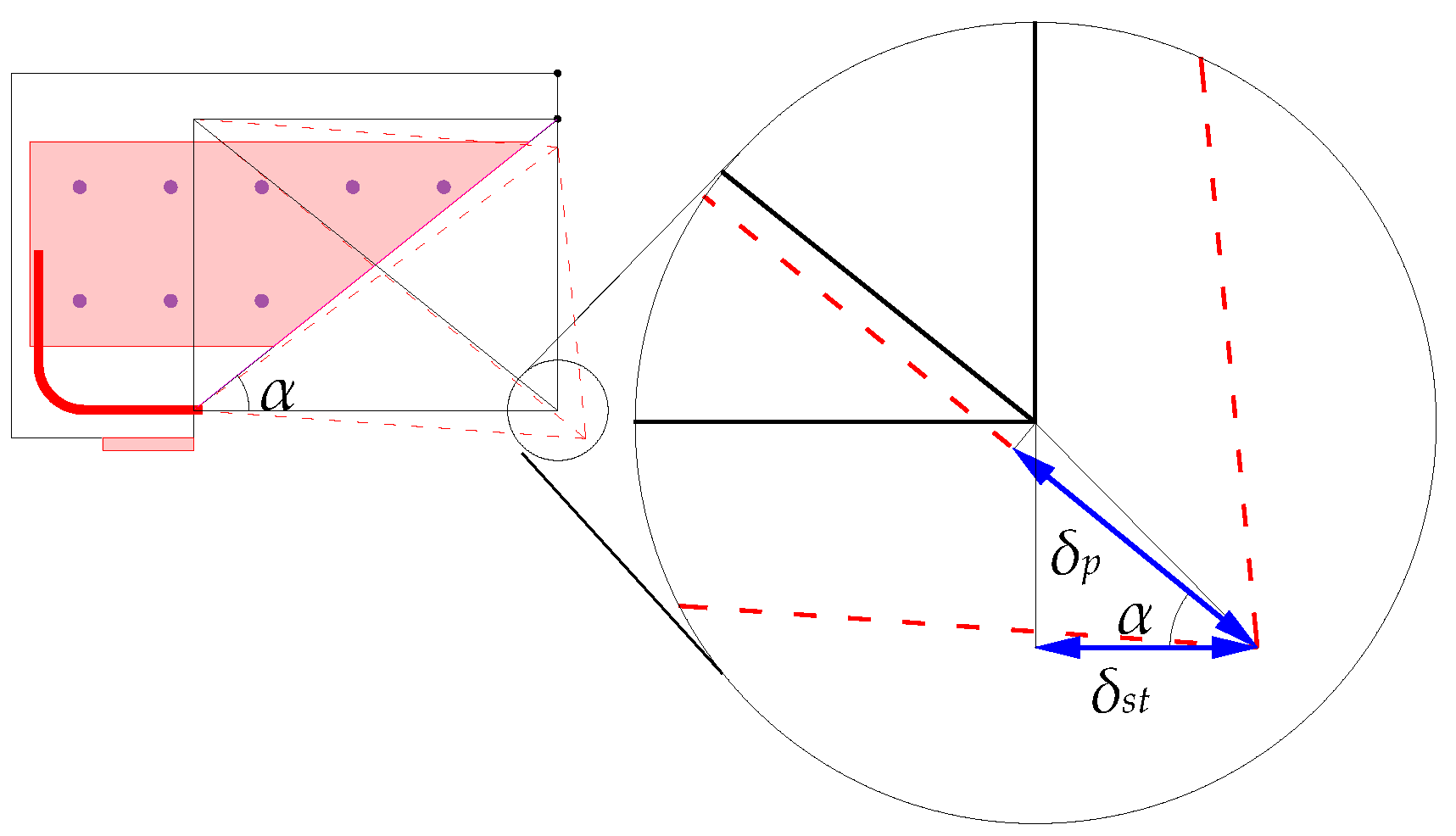

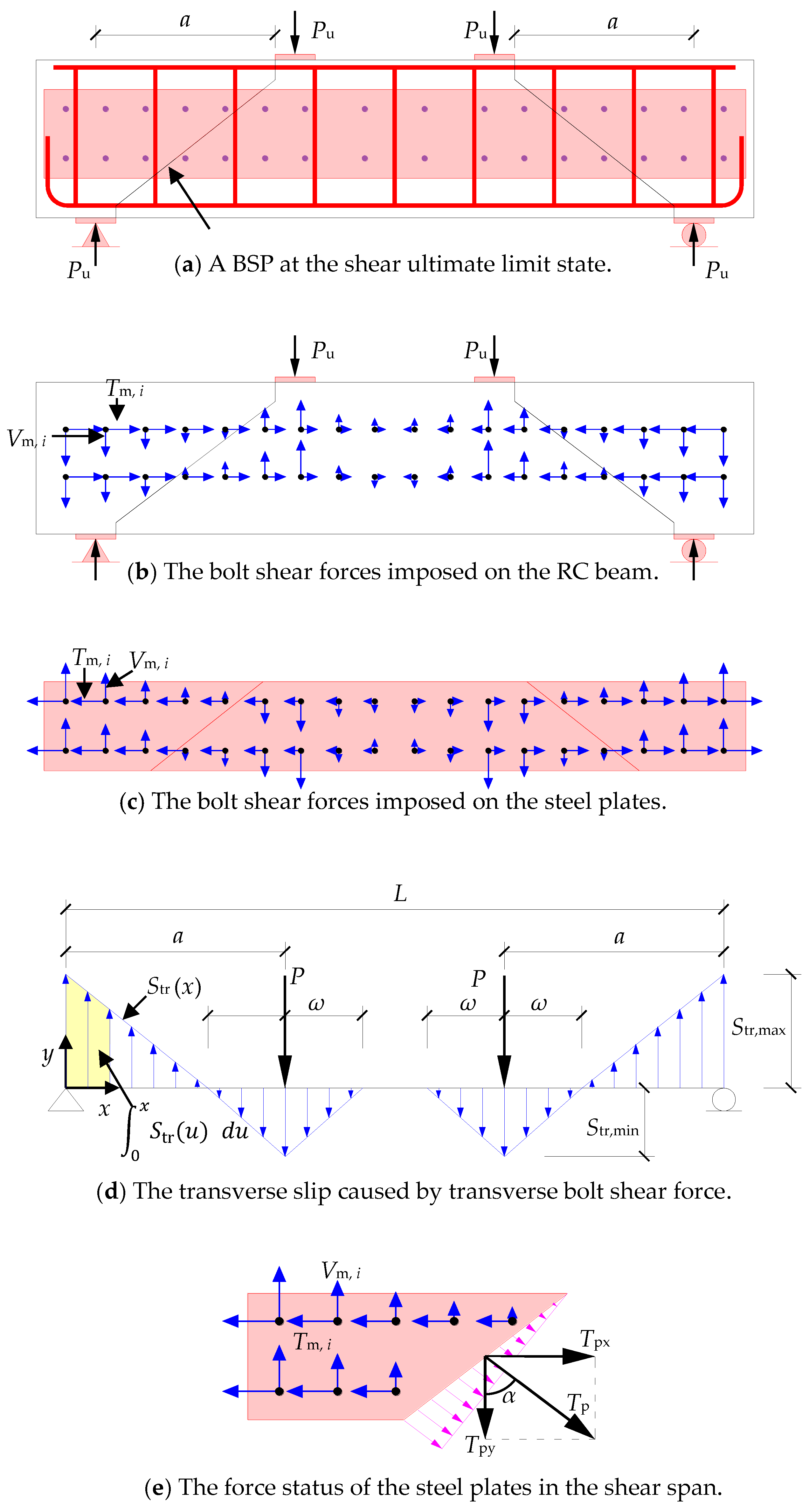
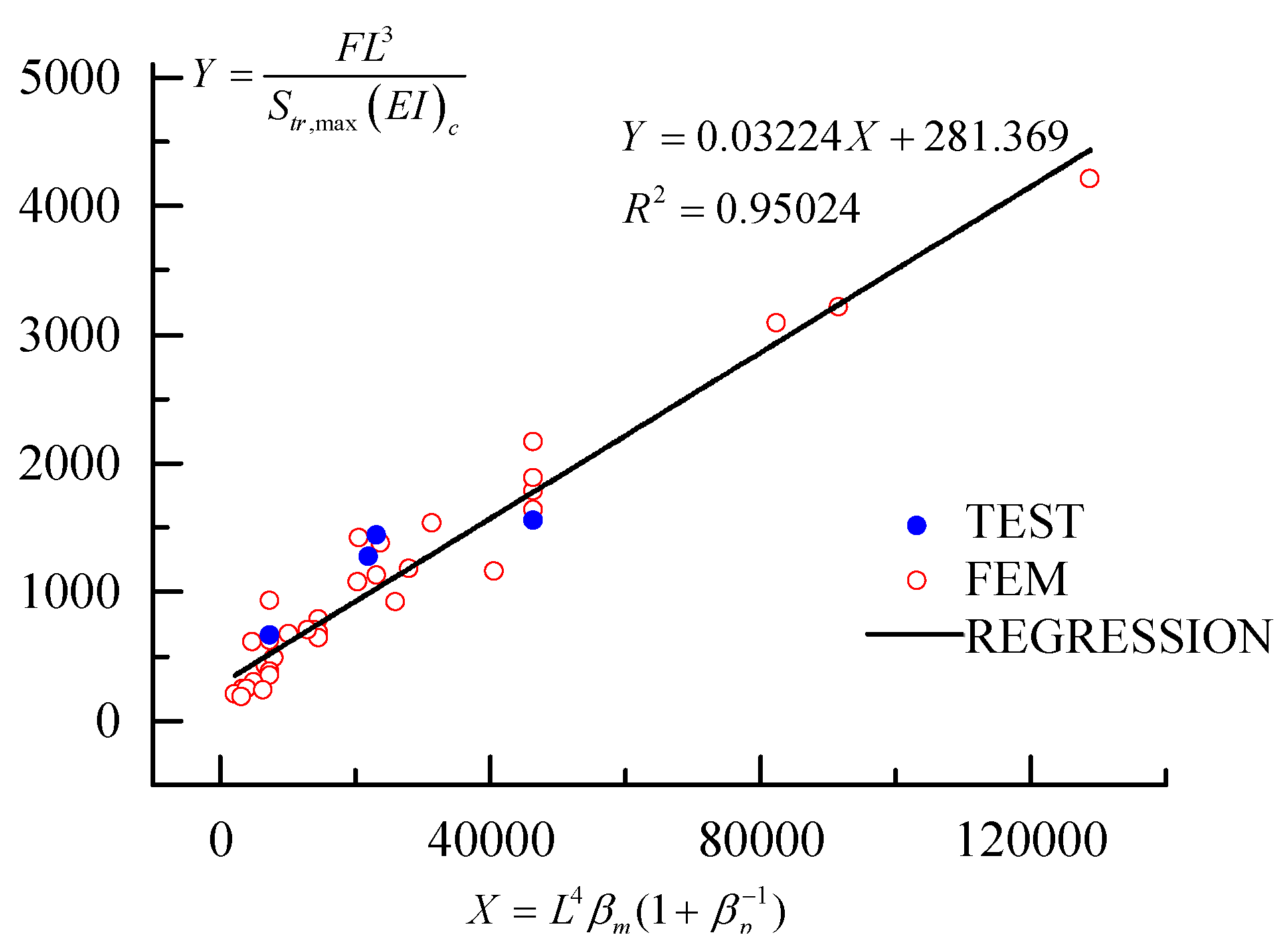
| Specimen | Shear Capacity (kN) | Ultimate Displacements (mm) | ||||
|---|---|---|---|---|---|---|
| Experimental | Numerical | Error | Experimental | Numerical | Error | |
| Control | 947 | 902.2 | −5.8% | 10.6 | 9.3 | 13.7% |
| P3B1 | 1409 | 1443.1 | 2.1% | 22.6 | 20.3 | 10.0% |
| P3B2 | 1260 | 1282.6 | 1.7% | 15.2 | 14.5 | 4.6% |
| P2B1 | 1174 | 1098.3 | −6.7% | 11.9 | 10.6 | 11.0% |
| P2B2 | 1090 | 1043.8 | −4.3% | 10.8 | 9.4 | 13.3% |
| Average absolute error: | 4.2% | Average absolute error: | 10.5% | |||
| Sample | Shear Capacity (kN) | Error | |||
|---|---|---|---|---|---|
| Experimental Pu,exp | Theoretical Model 1 Pu,the 1 | Theoretical Model 2 Pu,the 2 | |||
| P3B1 | 1409 | 1362 | 1513 | −3.3% | 7.4% |
| P3B2 | 1260 | 1218 | 1312 | −3.3% | 4.1% |
| P2B1 | 1174 | 1128 | 1076 | −3.9% | −8.3% |
| P2B2 | 1090 | 1101 | 1051 | −0.3% | −3.6% |
| Average absolute error: | 2.7% | 5.9% | |||
© 2018 by the authors. Licensee MDPI, Basel, Switzerland. This article is an open access article distributed under the terms and conditions of the Creative Commons Attribution (CC BY) license (http://creativecommons.org/licenses/by/4.0/).
Share and Cite
Liu, X.; Lu, Z.-D.; Li, L.-Z. The Use of Bolted Side Plates for Shear Strengthening of RC Beams: A Review. Sustainability 2018, 10, 4658. https://doi.org/10.3390/su10124658
Liu X, Lu Z-D, Li L-Z. The Use of Bolted Side Plates for Shear Strengthening of RC Beams: A Review. Sustainability. 2018; 10(12):4658. https://doi.org/10.3390/su10124658
Chicago/Turabian StyleLiu, Xin, Zhou-Dao Lu, and Ling-Zhi Li. 2018. "The Use of Bolted Side Plates for Shear Strengthening of RC Beams: A Review" Sustainability 10, no. 12: 4658. https://doi.org/10.3390/su10124658





